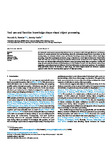Tool use and function knowledge shape visual object processing

Date
2021-09Author
Subject
Metadata
Show full item recordAbstract
Perceiving the environment automatically informs how we can interact with it through affordance mechanisms. However, it remains unknown how our knowledge about the environment shapes how it is perceived. In this training study, we evaluated whether motor and function knowledge about novel objects affects visual object processing. Forty-three participants associated a usage or function to a novel object in interactive virtual reality while their EEG was recorded. Both usage and function influenced the mu-band (8-12 Hz) rhythms, suggesting that motor and function object information influence motor processing during object recognition. Learning the usage also prevented the reduction of the theta-band (4-8 Hz) rhythms recorded over the posterior cortical areas, suggesting a predominant top-down influence of tool use information on visuo-motor pathways. The modulation being specifically induced by learning an object usage, the results support further the embodied cognition approach rather than the reasoning-based approach of object processing.
Collections
Publisher
Place of Publication
Journal
Volume
Pagination
Number
Recommended, similar items
The following license files are associated with this item:

